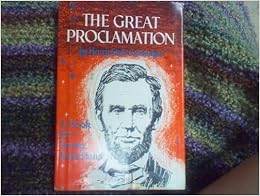 Award-winning children’s and young adult author Tonya Bolden “offers readers a unique look at an often misunderstood American document.” It is unique. Part 1 of this nonfiction book about the proclamation that “freed the slaves” begins with a quotation from Frederick Douglass, recounting the the atmosphere on Thursday, January 1, 1863 as about three thousand people waited at Tremont Temple in Boston for word from Washington, D.C. that the Emancipation Proclamation had been signed:
Award-winning children’s and young adult author Tonya Bolden “offers readers a unique look at an often misunderstood American document.” It is unique. Part 1 of this nonfiction book about the proclamation that “freed the slaves” begins with a quotation from Frederick Douglass, recounting the the atmosphere on Thursday, January 1, 1863 as about three thousand people waited at Tremont Temple in Boston for word from Washington, D.C. that the Emancipation Proclamation had been signed:
“We were waiting and listening as for a bolt from the sky . . . we were watching,as it were, by the dim light of the stars, for the dawn of a new day; we were longing for the answer to the agonizing prayers of centuries.”
Part 1 continues on in third person plural as if both author and reader were there, waiting, too. “We waited for all America to repent.” “We abhorred the compromise of 1850’s Fugitive Slave Law.” “Many of us put great faith in the fledgling Republican party.” Since I wasn’t there and since I’m not a “person of color”, I found the continued use of “we” and “us” to be off-putting, at best, confusing, at worst.
Then comes Part II which is written as straight third person history. The author tries to get behind the history and unravel the enigma of Lincoln’s thoughts and motivations, but like most other authors who’ve tired, she meets with limited success. Lincoln was “moody, prone to brooding,”; he “truly loathed slavery.” Yet, Lincoln told abolitionist Charles Edward Lester in regard to freeing the slaves, “We must wait until every other means has been exhausted. This thunderbolt will keep.” And so, throughout Part II of this narrative history, Lincoln is is pushed and pulled back and forth by the events of the Civil War and the politics of maintaining what there was left of the Union, and he proposes or considers first one solution and then another for the slaves: partial emancipation of some slaves, compensation to slaveholders, banning slavery in the territories, gradual emancipation, allowing escaped slavs (contraband) to enter the Union Army, confiscation of Confederate property including slaves, deportation of freed slaves and free black persons to Africa or South America.
 Part III returns to the disconcerting “we” for a couple of pages (p. 75-76) and then, inexplicably, back to third person narrative voice. I compared the entire book to the old classic children’s history of the same vent that I have on my shelves, The Great Proclamation by Henry Steele Commager, published in 1960. Other than the fact, dissonant to modern ears, that Mr. Commager calls African Americans “Negroes”, the book differs from Ms. Bolden’s account of the same events in other ways. Commager paints Lincoln as an unadorned hero, bravely attempting in every way possible to free the slaves as quickly as practicable. Commager does not quote Lincoln’s famous statement in a letter to Horace Greeley in 1862:
Part III returns to the disconcerting “we” for a couple of pages (p. 75-76) and then, inexplicably, back to third person narrative voice. I compared the entire book to the old classic children’s history of the same vent that I have on my shelves, The Great Proclamation by Henry Steele Commager, published in 1960. Other than the fact, dissonant to modern ears, that Mr. Commager calls African Americans “Negroes”, the book differs from Ms. Bolden’s account of the same events in other ways. Commager paints Lincoln as an unadorned hero, bravely attempting in every way possible to free the slaves as quickly as practicable. Commager does not quote Lincoln’s famous statement in a letter to Horace Greeley in 1862:
“If I could save the Union without freeing any slave I would do it, and if I could save it by freeing all the slaves I would do it; and if I could save it by freeing some and leaving others alone I would also do that. What I do about slavery, and the colored race, I do because I believe it helps to save the Union; and what I forbear, I forbear because I do not believe it would help to save the Union.”
That statement of intent should be a part of any discussion of Lincoln and his attitude about emancipation, and Ms. Bolden includes it prominently in her book. Ms.Bolden’s book also has the great advantage of 21st century illustration techniques, layout and design. Mr. Commager’s text in a layout similar to that of Ms. Bolden’s book would be a great improvement. However, what Mr. Commager does well is tell the story of the “great proclamation” straight, without the confusing changes in point of view. So, in the end I think I would either go with Commager’s book or find something else that would be less poetic and and more attuned to current historical perspectives than either of these books. There seem to be several to choose from.
Other books for children on the Emancipation Proclamation (found on Amazon):
Lincoln, Slavery, and the Emancipation Proclamation by Carin T. Ford.
The Emancipation Proclamation by Karen Price Hossell.
The Emancipation Proclamation (Cornerstones of Freedom) by Brendan January and R. Conrad Stein.
The Emancipation Proclamation: Ending Slavery in America by Adam Woog.
Emancipation Proclamation: Lincoln and the Dawn of Liberty by Tonya Bolden has been nominated for the Cybils Award in the category of Young Adult Nonfiction. The thoughts in this review are my own and do not reflect the thoughts or evaluations of the Cybils panel or of any other Cybils judge.